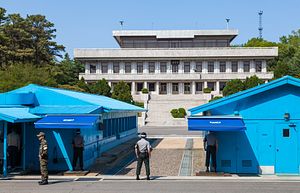The ‘August Crisis’ between South Korea and North Korea appears to have come to a close. As my colleague Franz-Stefan Gady reported, Pyongyang has agreed to apologize for its provocative behavior and, in return, Seoul will cease propaganda broadcasts across the demilitarized zone (DMZ) separating the two countries. Seoul resumed broadcasts for the first time in more than a decade after two South Korean soldiers suffered injuries from a North Korean land mine, the first North Korean provocation to result in South Korean casualties since Kim Jong-un took over the Hermit Kingdom.
For long-time observers of the Koreas, it always seemed slim that this period of escalating rhetoric and action would be the one to thrust the Korean peninsula back into all-out war. What may have been less obvious, before the inter-Korean talks kicked off at Panmunjom, were the actions both sides could take to return to the status quo, before the land mine incident. For both states, a resolution that did not allow their leadership to save face would have been intolerable. Fortunately, neither Seoul’s actions nor Pyongyang’s seemingly brazen series of provocations caused a scenario where both Koreas had their backs to the wall. Room for a face-saving compromise was possible as long as Seoul responded to Pyongyang’s provocations carefully.
And Seoul’s response was “careful” even if it wasn’t proportionate. Indeed, Seoul managed to test its “disproportionate response” deterrence approach during this crisis. Its response to Pyongyang’s cross-border shelling, directed at a propaganda tower, was disproportional. As Franz notes, Seoul fired between 29 and 36 155 mm artillery rounds in response to four initial artillery strikes by the North (first, one 14.55 mm shell, and then three 76.2 mm rounds). In doing so, for better or worse, South Korea shows that it is serious about kinetic retaliation and imposing costs on the North. A more restrained South Korean response could have been unconvincing, provoking Kim to test his hand by ramping up provocations.
Critically, today’s agreement may not have been possible if Seoul hadn’t initially stated its demand for an apology over the August 4 land mine incident. Indeed, before the two sides exchanged fire and before North Korea declared a “quasi” state of war, Seoul had set out its goals. With today’s agreement, Seoul walks away satisfied with its initial concession demand, and Pyongyang does so as well: propaganda broadcasts won’t resume across the border.
And so, crisis averted: things return to “normal” on the Korean peninsula.

































